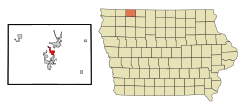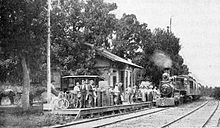Okoboji is a city in Dickinson County, Iowa, United States, along the eastern shore of West Okoboji Lake in the Iowa Great Lakes region. At the time of the 2020 census, its population was 768.[2]
Okoboji, Iowa | |
|---|---|
 Location of Okoboji, Iowa | |
| Coordinates: 43°23′15″N 95°8′17″W / 43.38750°N 95.13806°W | |
| Country | |
| State | |
| County | Dickinson |
| Government | |
| • Mayor | Mary VanderWoude |
| • City Administrator | Michael Meyers |
| Area | |
• Total | 1.76 sq mi (4.56 km2) |
| • Land | 1.76 sq mi (4.55 km2) |
| • Water | 0.01 sq mi (0.01 km2) |
| Elevation | 1,421 ft (433 m) |
| Population (2020) | |
• Total | 768 |
| • Density | 437.11/sq mi (168.77/km2) |
| Time zone | UTC-6 (Central (CST)) |
| • Summer (DST) | UTC-5 (CDT) |
| ZIP code | 51355 |
| Area code | 712 |
| FIPS code | 19-58710 |
| GNIS feature ID | 0459815 |
| Website | okobojicity |

Geography
editAccording to the United States Census Bureau, the city has a total area of 1.86 square miles (4.82 km2), of which 1.85 square miles (4.79 km2) is land and 0.01 square miles (0.03 km2) is water.[3]
Demographics
edit| Year | Pop. | ±% |
|---|---|---|
| 1930 | 176 | — |
| 1940 | 271 | +54.0% |
| 1950 | 336 | +24.0% |
| 1960 | 330 | −1.8% |
| 1970 | 361 | +9.4% |
| 1980 | 559 | +54.8% |
| 1990 | 775 | +38.6% |
| 2000 | 820 | +5.8% |
| 2010 | 807 | −1.6% |
| 2020 | 768 | −4.8% |
| Source:"U.S. Census website". United States Census Bureau. Retrieved March 29, 2020. and Iowa Data Center Source: | ||
2020 census
editAs of the census of 2020,[5] there were 768 people, 425 households, and 238 families residing in the city. The population density was 437.1 inhabitants per square mile (168.8/km2). There were 1,214 housing units at an average density of 690.9 per square mile (266.8/km2). The racial makeup of the city was 97.4% White, 0.3% Black or African American, 0.0% Native American, 0.4% Asian, 0.0% Pacific Islander, 0.7% from other races and 1.3% from two or more races. Hispanic or Latino persons of any race comprised 1.6% of the population.
Of the 425 households, 15.8% of which had children under the age of 18 living with them, 46.1% were married couples living together, 4.9% were cohabitating couples, 31.8% had a female householder with no spouse or partner present and 17.2% had a male householder with no spouse or partner present. 44.0% of all households were non-families. 39.3% of all households were made up of individuals, 21.2% had someone living alone who was 65 years old or older.
The median age in the city was 60.6 years. 13.2% of the residents were under the age of 20; 4.0% were between the ages of 20 and 24; 14.1% were from 25 and 44; 26.8% were from 45 and 64; and 41.9% were 65 years of age or older. The gender makeup of the city was 47.0% male and 53.0% female.
2010 census
editAs of the census[6] of 2010, there were 807 people, 427 households, and 241 families living in the city. The population density was 436.2 inhabitants per square mile (168.4/km2). There were 1,167 housing units at an average density of 630.8 per square mile (243.6/km2). The racial makeup of the city was 98.8% White, 0.1% African American, 0.1% Asian, 0.5% from other races, and 0.5% from two or more races. Hispanic or Latino of any race were 2.6% of the population.
There were 427 households, of which 14.1% had children under the age of 18 living with them, 48.5% were married couples living together, 5.2% had a female householder with no husband present, 2.8% had a male householder with no wife present, and 43.6% were non-families. 35.6% of all households were made up of individuals, and 16.4% had someone living alone who was 65 years of age or older. The average household size was 1.89 and the average family size was 2.39.
The median age in the city was 55.2 years. 11.8% of residents were under the age of 18; 5.3% were between the ages of 18 and 24; 18.6% were from 25 to 44; 35.3% were from 45 to 64; and 29% were 65 years of age or older. The gender makeup of the city was 48.9% male and 51.1% female.
2000 census
editAs of the census[7] of 2000, there were 820 people, 427 households, and 240 families living in the city. The population density was 460.0 inhabitants per square mile (177.6/km2). There were 944 housing units at an average density of 529.6 per square mile (204.5/km2). The racial makeup of the city was 98.66% White, 0.12% African American, 0.73% Native American, 0.12% from other races, and 0.37% from two or more races. Hispanic or Latino of any race were 0.73% of the population.
There were 427 households, out of which 16.2% had children under the age of 18 living with them, 50.6% were married couples living together, 3.5% had a female householder with no husband present, and 43.6% were non-families. 38.6% of all households were made up of individuals, and 17.1% had someone living alone who was 65 years of age or older. The average household size was 1.92 and the average family size was 2.50.
In the city, the population was spread out, with 14.3% under the age of 18, 7.2% from 18 to 24, 20.9% from 25 to 44, 30.0% from 45 to 64, and 27.7% who were 65 years of age or older. The median age was 49 years. For every 100 females, there were 100.0 males. For every 100 females age 18 and over, there were 100.9 males.
The median income for a household in the city was $37,500, and the median income for a family was $54,659. Males had a median income of $32,500 versus $24,018 for females. The per capita income for the city was $29,297. About 2.6% of families and 5.3% of the population were below the poverty line, including 5.0% of those under age 18 and 3.8% of those age 65 or over.
Education
editMost of the community is served by the Okoboji Community School District.[8] The district was established on July 1, 1988 by the merger of the Arnolds Park and Milford school districts.[9] Okoboji High School in Milford is the local high school.
Tourism
editThis section needs additional citations for verification. (October 2007) |
Okoboji is a major summer tourism area, often referred to as "the Hamptons of the Midwest". A growing number of resorts around the Iowa Great Lakes and the proximity of other tourist-friendly sites, such as Arnolds Park[10] and Spirit Lake, have contributed to its growing popularity. Okoboji has also become a recognizable name around the country due to the sales of many products that proudly display the town name in bold letters. Visitors to Okoboji will immediately notice bumper stickers, mugs, and sweatshirts touting the fictitious University of Okoboji where many locals claim to have received an education.[11] University of Okoboji T-shirts or sweatshirts are popular with college students in the Midwest.
References
edit- ^ "2020 U.S. Gazetteer Files". United States Census Bureau. Retrieved March 16, 2022.
- ^ a b "2020 Census State Redistricting Data". census.gov. United states Census Bureau. Retrieved August 12, 2021.
- ^ "US Gazetteer files 2010". United States Census Bureau. Archived from the original on January 12, 2012. Retrieved May 11, 2012.
- ^ "Census of Population and Housing". Census.gov. Retrieved June 4, 2015.
- ^ "2020 Census". United States Census Bureau.
- ^ "U.S. Census website". United States Census Bureau. Retrieved May 11, 2012.
- ^ "U.S. Census website". United States Census Bureau. Retrieved January 31, 2008.
- ^ "Okoboji" (PDF). Iowa Department of Education. Retrieved March 24, 2020.
- ^ "REORGANIZATION & DISSOLUTION ACTIONS SINCE 1965-66" (PDF). Iowa Department of Education. Archived from the original (PDF) on February 9, 2019. Retrieved March 22, 2020.
- ^ "Arnolds Park $15 Million Makeover Bringing Return of Roof Garden". June 8, 2019.
- ^ "University of Okoboji entrance exams center around fun".